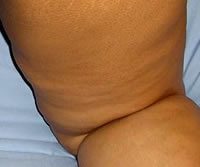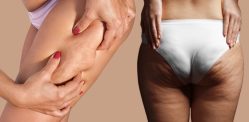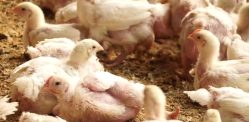Overweight women are not only prone to cellulite
There is a myth that many women of South Asian origin feel that cellulite is a problem mainly experienced by European, North American and Western women in general. However, the truth of the matter is that cellulite is a problem that occurs in Desi women too, and is on the increase due to changes in lifestyle. Especially, due to more westernised diets and lack of exercise.
What is Cellulite? Well, cellulite is the dimpled appearance of skin caused by fat deposits that are just below the surface of the skin. It’s mainly the result of poor circulation and drainage, and is a combination of fluid retention and fatty tissue. It’s a result of the fibres tightening their hold on the fat cells which then leads to that stubborn, ugly dimpling, ‘orange peel’ effect. It’s given other names such as orange peel syndrome, cottage cheese skin, mattress phenomenon and hail damage.

Cellulite appears commonly on the back and side of a woman’s thighs, tummy and the buttocks. The thighs and buttocks of women tend to store more of this body fat. Overweight women are not only prone to cellulite. You can be of any shape or size and still have cellulite. Over 80% of women in the West have cellulite to some degree and this includes skinny people, celebrities, and even supermodels. Now, Desi women are experiencing an increase in this category too, especially in the UK, USA and Canada.

How does cellulite occur? There are many things that cause cellulite in women, including poor diet, smoking, lack of exercise, increased hormones, particular genes and older age.

Diet is on of the most common causes of cellulite. Those who eat a large amount of saturated fat, salt and carbohydrates, and consume less fibre, are more likely to develop cellulite than people eating healthy diets. Root causes include high consumption of junk food and alcohol.
A lack of exercise, especially targeting the thighs, abdomen and buttocks, leads to cellulite appearing. If you had an active lifestyle and it progressively stopped due to changes in lifestyle or lack of time, you are prone to cellulite due to the once toned muscles becoming slack and fatty tissues increasing.

Genes can play a role too, especially those that determine characteristics like gender, race, metabolic rate, distribution of fat just underneath the skin, and circulatory insufficiency of a person, can contribute to cellulite.
Interestingly, clothing can aid the increase of the ‘orange peel’ effect. Especially, wearing underwear with tight elastics around the buttocks area can also contribute to the fast development of cellulite in the skin.

So how can it be controlled or reduced? There are many therapies and treatments that have been devised to tackle the problem of this fatty tissue. However, none of them are fully supported by scientific or medical endorsement. Some may show some improvements for some people but not everyone.
Treatments for cellulite include oral drugs and creams. Such as methylxanthines (caffeine and theobromine), pentoxifylline, beta-agonists and adrenaline, alpha-antagonists, amino acids, ginkgo biloba, rutin, and Indian chestnut amongst others. These have been applied topically, orally, or by injection, but none have been proved to be 100% effective. So, if you see a ‘wonder’ drug designed to eliminate cellulite, think twice about its overall effectiveness.
The therapeutic methods that are physical, mechanical or electrical include heat therapy, pneumatic massages, massages that stimulate lymphatic flow, ultrasound, radio frequency therapy, magnetic therapy, radial waves therapy, Endermologie, and electrical stimulation. However, there is no real evidence that supports the effectiveness of these methods.
One of the most advertised forms of cellulite reduction techniques is liposuction. This method does not remove cellulite and in fact can make it worse.

The only sure way to try and reduce cellulite is by eating healthy, regular exercise and maintaining your weight. In addition wearing thongs, boy-shorts, or looser fitting undergarments can prevent cellulite that might form due to tight elastic.
Your diet needs to consist of lots of low fat foods such as coloured fruits, vegetables, fibre and fish oil. Broccoli and blueberries are top of the list. Stay away from junk food and artificial sweeteners. Drinking water is a major health benefit but will not cure cellulite because cellulite is not toxin related.
For exercise, use a combo of aerobic cardio and strength training. Exercise your whole body for around half an hour up to five times a week for best results and include dancing, cycling, sit-ups, squats and leg curls and long stretches in your regime. The work out will improve your circulation, removes excess fluid and tones muscles; making the skin look smoother and reduce the appearance your cellulite.
Keep on top of your weight to avoid the ‘yo-yo’ effect, which stretches the connective tissue in your skin and makes cellulite worse. And if your weight’s fine, don’t try to lose more trying to reduce cellulite because it will not make much of a difference.
With the advent of junk food in India and other countries in South Asia. It is likely, we will see cellulite appearing more commonly on South Asian women too, like the familiar sight seen on many British Asian women today. But we are not alone because the Bollywood starlets, pop singers and models have it too.




























































